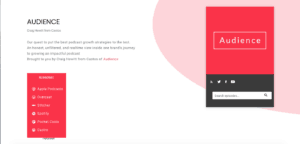Welcome back to Castos Office Hours, our weekly podcast webinar focused on answering your most pressing questions live. Everything from gear, launch plans, audience growth, to Castos feature updates, we’re covering it all!
In this edition, our CEO, Craig, walked us through five different strategies to engage with an audience outside of your podcast. We talked Facebook groups and live meetups plus how to ask your guest to interact with listeners to take the conversation one step further. Then, as always, we jumped into attendee questions providing our take on host-read versus scripted ads and how to manage publishing frequencies to best serve your audience.
Check out the full webinar below for every last detail or our summary of what went down. And don’t forget to RSVP to our next session on Wednesday, October 9th at 12:00pm EDT here.

Podcast Software Questions
I’m planning on hosting a roundtable episode but my guests are spread out around the country. Which recording software should I use?
The main feature you need to consider in this situation is remote recording capabilities. When your guests aren’t sitting in the same room as you, you’ll want to capture their audio on a separate track and have them store the files locally as you’re recording for optimal sound quality. We think Zencastr and Squadcast get the job done perfectly and we’ve also rounded a few other top podcast recording softwares to consider.
Podcast Sponsorship Questions
How can you retain your podcast’s original voice and message as you bring on more sponsors?
With podcast sponsorship still in its infancy, many hosts are still figuring out the intricacies of selling airtime on their shows. There isn’t a set standard for partnership terms so there is a lot of flexibility in how you choose to feature advertisers. The first criteria you should apply to every potential sponsor is their alignment with your audience and podcast’s message. Your audience trusts your opinion and you could risk losing some credibility if an advertiser’s message goes against your show’s ethos. For example, if you talk about the thrills and benefits of buying vintage clothes, it would be out of left field to then advertise Macy’s latest sale. Also be weary of whether or not a sponsor detracts from your podcast’s brand. Be sure not to lose sight of the negative effects of associating with advertisers your audience would never support solely for short term monetary gain.
As you build your roster of advertisers, think about the potential loss of creative control and ownership of your show. You’re likely not making your podcast just to talk about sponsor products so take care to work with the brands you’re excited to champion to your audience.
Do you recommend host-read or scripted ads for sponsored products?
Time and again the data points to host-read ads driving increased engagement and it’s easy to see why. The messages are presented in the same voice as the host, both literally and in the tone of the show. Host-read ads show personality and better relate sponsor’s products to the needs of an audience. Advertisements break up the content listeners are there to enjoy, but a host-read advertisement provides a more seamless transition between the commercial break and episode encouraging them to actually listen to the sponsor’s message.
As you bring on sponsors, it’s worth pushing the benefits of host-read ads as it’s a win/win situation for everyone involved–your audience feels less alienated and sponsors receive more engagement. Ask advertisers about the core message they want included in their placements then tweak the script to fit your show’s voice. Send a cut to the sponsor for a final review then seamlessly add in your host-read ads into each episode.
Podcast Frequency Question
How many episodes is too many? I’m currently publishing three per week but am unsure if it’s sustainable.
At the bare minimum, we suggest publishing one new episode every two weeks. This ensures your audience doesn’t forget about your podcast and keeps them engaged. As you decide your publishing schedule, remember the less frequent you post content, the less opportunities your audience has to engage with you.
If you’re started at a higher volume and feel the need to ratchet back a bit, be honest with your audience about the change. They’ve come to expect new episodes on a certain day so altering your schedule without notice may look as if you don’t take your podcast seriously. To manage expectations, announce the changes at the end of a few episodes or make a shorter teaser clip that details when you plan to publish new content and potentially dig into why you’re implementing the change. This way, everyone is on the same page and you’ve avoided any confusion.
